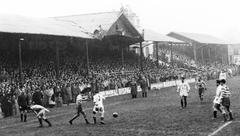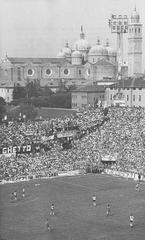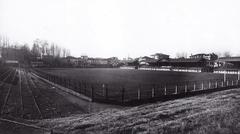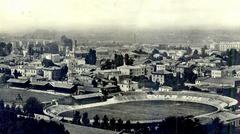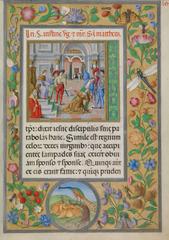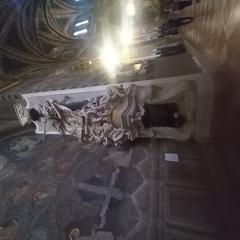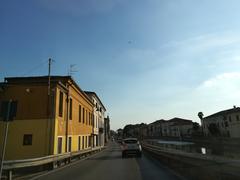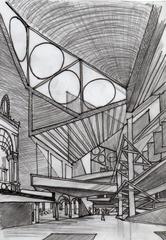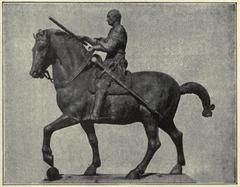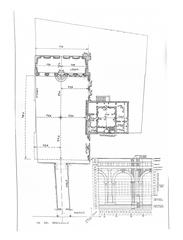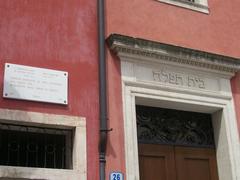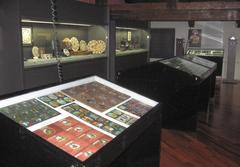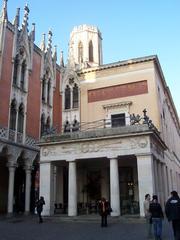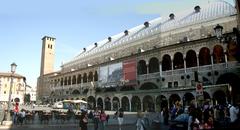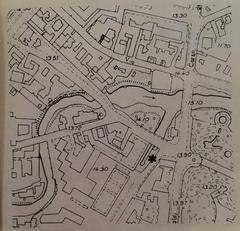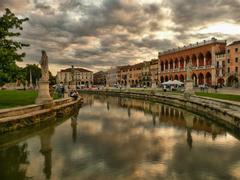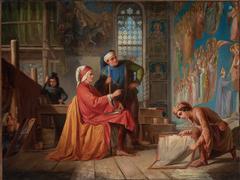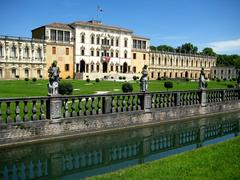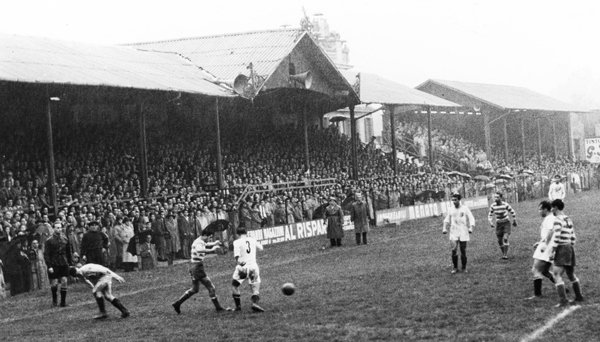
Visiting Stadio Silvio Appiani in Padua, Italy: The Complete Guide (Hours, Tickets, and Nearby Attractions)
Date: 14/06/2025
Introduction
Stadio Silvio Appiani, nestled in the historic city of Padua, Italy, is a living monument to the city’s sporting heritage, architectural charm, and cultural identity. Inaugurated in 1924 and named after the young footballer and war hero Silvio Appiani, the stadium has witnessed decades of memorable matches, passionate fan gatherings, and significant civic events. Its intimate design—stands close to the pitch, inspired by English grounds—and its proximity to landmarks like the Basilica di Santa Giustina have helped it become a beloved fixture in Padua’s urban landscape. Today, Appiani continues to host amateur matches and community events, serving as both a heritage site and a vibrant part of local life.
This guide provides a comprehensive overview of Stadio Silvio Appiani’s history, significance, practical visitor information, ticketing details, accessibility, and recommendations for nearby attractions. Whether you’re a football aficionado, history enthusiast, or a traveler seeking authentic Padua experiences, this resource will help you plan a meaningful visit.
Contents
- Origins and Construction
- Naming and Early Identity
- Architectural Features and Capacity
- Sporting Milestones and Cultural Significance
- Social and Civic Role
- Decline, Transformation, and Preservation
- Visiting Stadio Silvio Appiani: Practical Information
- Visiting Hours
- Tickets and Entry
- Accessibility
- Getting There
- Nearby Attractions
- FAQs
- Conclusion
- Sources
Origins and Construction
Stadio Silvio Appiani was conceived in the early 1920s in response to the growing popularity of football and the ambitious vision of Calcio Padova’s supporters and the city council. Construction began in 1921 and, after three years, the stadium was inaugurated on October 19, 1924. The opening match saw Calcio Padova secure a resounding 6-1 victory over Andrea Doria, marking the beginning of a new era for sport in the city (Il Gazzettino).
Naming and Early Identity
Initially nicknamed “La Fossa dei Leoni” (the Lion’s Den) for its electrifying matchday atmosphere and the closeness of fans to the pitch, the stadium was soon renamed in honor of Silvio Appiani. Appiani, a promising young Padovan footballer, died in World War I at the age of 21. His memory and values—courage, athleticism, and sacrifice—became integral to the stadium’s identity (La Soga).
Architectural Features and Capacity
Appiani’s design drew inspiration from English football grounds, with stands built close to the playing field to foster an intense, immersive experience. At its peak, the stadium could accommodate up to 24,000 spectators, with 10,000 seated. The reinforced concrete main grandstand offered commanding views, while the east stand became synonymous with Padova’s most passionate supporters. The stadium’s location, adjacent to Santa Giustina’s domes, further anchored it within Padua’s historical landscape (La Soga).
Sporting Milestones and Cultural Significance
For seventy years, Stadio Silvio Appiani was the pulsating heart of Calcio Padova’s football culture. Legendary matches—including the 4-4 draw against Grande Torino in 1949 and Padova’s third-place finish in Serie A in 1958 under coach Nereo Rocco—cemented its reputation. The stadium also hosted matches for Italian national teams and became the birthplace of Padova’s first organized supporter groups, such as ACP 1910-Ultras Padova and HAG-Hell’s Angels Ghetto (La Soga).
Social and Civic Role
More than a sports venue, Appiani served as a “tempio laico” (secular temple) for Padovani. It was a gathering place for events beyond football—including a historic visit by Pope John Paul II—and is featured in countless family photographs. The bond between supporters and the club was so strong that, in 1926, fans collectively paid a fine imposed for crowd behavior during a match (Il Gazzettino; La Soga).
Decline, Transformation, and Preservation
By the 1990s, Appiani’s limitations—capacity and safety standards—necessitated Calcio Padova’s move to the new Stadio Euganeo in 1994 (Stadium Guide). The last official match at Appiani was a 0-0 draw with Palermo on May 29, 1994 (La Soga).
Rather than being abandoned, the stadium underwent restoration: in 2009, the east stand was partially demolished and rebuilt, a pedestrian walkway was created, and capacity was reduced to 2,000. Further renovations in 2015 introduced new seating, commemorative panels, and glass parapets to preserve its historic ambiance (Wikipedia - Stadio Silvio Appiani). Today, the stadium is a cherished heritage site, hosting amateur matches and community events, with a scale model on display at Stadio Euganeo’s museum (La Soga).
Visiting Stadio Silvio Appiani: Practical Information
Visiting Hours
- General Access: Typically open during daylight hours (9:00 AM – 6:00 PM), especially on weekends and matchdays.
- Guided Tours: Limited availability; check local tourism resources or contact the Padova Calcio museum for appointments.
Tickets and Entry
- Amateur Matches: Tickets are modestly priced and sold at the entrance.
- Casual Visits: Admission is usually free outside of matchdays; donations for preservation are welcomed.
- Special Events/Tours: Check official channels for schedules and ticketing (Padova Calcio).
Accessibility
Recent renovations have improved accessibility, including ramps and designated seating. However, some historic areas remain difficult to access for wheelchair users. Contact the visitor office in advance for assistance.
Getting There
- By Public Transport: Well served by city buses; stops near Prato della Valle and Santa Giustina.
- On Foot/Bicycle: Walking distance from city center; cycling paths available.
- Parking: Limited; using public transport or parking farther away is recommended.
Nearby Attractions
- Prato della Valle: Italy’s largest square and popular gathering spot.
- Basilica di Santa Giustina: Majestic church adjacent to the stadium.
- Padua’s Renaissance City Walls: Offers historical context and scenic views.
Frequently Asked Questions (FAQ)
Q: What are the opening hours of Stadio Silvio Appiani?
A: Generally, 9:00 AM – 6:00 PM, but confirm ahead for special events or restoration closures.
Q: Is there an admission fee?
A: Entry is usually free; guided tours or special events may require tickets.
Q: How do I get to the stadium?
A: Easily reached by public transport, bicycle, or on foot from Padua’s center.
Q: Is the stadium accessible for visitors with disabilities?
A: Yes, in renovated areas; contact ahead for details.
Q: Can I watch professional matches here?
A: No, professional matches are at Stadio Euganeo. Appiani hosts youth and amateur games.
Q: Are guided tours available?
A: Limited and by appointment; check official sources for availability.
Q: What else is there to see nearby?
A: Prato della Valle, Basilica di Santa Giustina, city walls, and Padua’s historic center.
Conclusion
Stadio Silvio Appiani remains a powerful symbol of Padua’s sporting and cultural history—an architectural gem, a community gathering place, and a living link to the city’s past. Its evocative setting, storied legacy, and ongoing preservation efforts make it a must-visit for anyone interested in the heart and soul of Padua.
For the latest information on hours, tickets, and events, refer to official tourism resources and Calcio Padova’s website. Enhance your experience by exploring nearby landmarks and engaging with the local community. To stay updated, download the Audiala app and follow local tourism platforms.
Sources
- Il Gazzettino: Stadio Silvio Appiani History
- La Soga: Stadio Silvio Appiani
- PadovaOggi: 100 Years of Stadio Silvio Appiani
- Wikipedia (IT): Stadio Silvio Appiani
- Stadium Guide: Stadio Euganeo
- Padua Tourism Official Website
- Rivista Contrasti: Padova Calcio History
